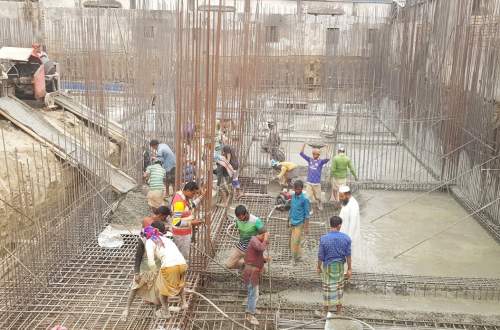The raft foundation is a very commonly used type of foundation system. Raft foundation is also known as Mat foundation. Definition of raft foundation along with working principle, when to choose raft, types of raft foundation, materials of raft foundation, raft construction steps etc are discussed below.
What is the Raft Foundation?
Raft foundation is actually a thick concrete slab resting on a large area of soil reinforced with steel, supporting columns or walls and transfer loads from the structure to the soil. Usually, mat foundation is spread over the entire area of the structure it is supporting.
Raft foundation is generally used to support structures like residential or commercial buildings where soil condition is poor, storage tanks, silos, foundations for heavy industrial equipment etc.

Working Principle of Raft Foundation
To get a better idea about when to use raft foundation, it is important to understand how raft foundation works. Let’s get a quick review of its working principle.
Raft foundation transmits the total load from the building to the entire ground floor area. Stress distribution mechanism of raft foundation is very simple. Total weight of the structure and self-weight of the mat is calculated and is divided by the total area of the foundation it is covering to calculate the stress on the soil.
As in case of raft foundation the contact area of the foundation with soil is much more than any other type of foundation, so the load is distributed over a larger area and thus the stress on soil is lesser and the possibility of shear failure of soil is also reduced.
When to Choose Raft Foundation
For foundation design, one of the most important aspects is choosing the right type of foundation. Raft foundation is preferred when-
- The soil has a low bearing capacity.
- Load of the structure has to be distributed over a large area.
- Individual or any other foundation area would approximately cover 50% of the total ground area beneath the structure.
- The columns or walls are placed so closely that the individual footings would overlap.
- Stress on soil needs to be reduced.
- There is a possibility of differential settlement in case individual footing is used.
- When soil strata are unpredictable and contain pockets of compressible soil.
- Basement is to be constructed.
- Any other type of footing cannot be used advantageously.
{adselite}
Types of Raft Foundation
Several types of Raft foundation may be used depending on the condition of soil and the load imposed on the foundation.
Followings are the different types of raft foundation used in construction:
- Flate plate mat
- Plate thickened under the column
- Two-way beam and slab Raft
- Plate raft with pedestals
- Plied raft
- Rigid Frame Mat or Cellular Raft Foundation
Different types of mat foundation are briefly discussed below.
1. Flat Plate Mat
This is the simplest form of raft foundation. This type of mat is used when the columns and walls are uniformly spaced at small intervals and the subjected loads are relatively small. Reinforcement is placed in both directions and more reinforcement is required at the column locations and load-bearing walls. The thickness of this types of raft foundation is generally restricted within 300mm for economic reason. A thicker slab would not be economical.
2. Plate Thickened under Columns
When the columns and load bearing walls are subjected to heavier loads, the slab is thickened under the columns and walls and extra reinforcement is provided to resist against diagonal shear and negative reinforcement.
3. Two-way Beam and Slab
In this type of raft, beams are cast monolithically with the raft slab connecting the columns and walls. This type of raft is suitable when the columns are placed at a larger distance and the loads on the columns are variable.
4. Plates with Pedestals
In this type of mat, a pedestal is provided at the base of the columns. Purpose of this type of foundation is same as flat plate thickened under columns.
5. Piled Raft
This type of raft foundation is supported on piles. A piled raft is used when the soil at a shallow depth is highly compressible and the water table is high. Piles under raft help in reducing settlement and provides resistance against buoyancy.
6. Rigid Frame Mat/Cellular Raft Foundation
In this type of raft, the foundation walls act as a deep beam. Rigid frame mat is referred when columns carry extremely heavy loads and the connecting beams exceeds 90cm depth. Here two concrete slabs are placed, one on top of another and connected with foundation walls in both directions and thus forms a cellular raft foundation. This type of raft is very rigid and is economical when the required slab thickness is very high.
Materials Used for Raft Foundation Construction
Here are some materials used for the erection of Raft foundation-
- Formwork
- Spacer
- Reinforcement
- Concrete.
Construction Process of Raft foundation
Key steps of Raft foundation construction are noted below.
- Identify the desired depth at which foundation is to be provided.
- Excavate soil up to the required depth.
- Compact the soil.
- Provide a waterproofing membrane.
- Pour 3” of plane cement-sand paste.
- Lay reinforcement maintaining the required spacing using spacers.
- Pour concrete to the desired depth.
- Curing.
To conclude, mat is one of the most common and popular type of foundation system due to its simple construction process and its effectiveness where soil condition is poor at a shallow depth. One must investigate the soil condition and analyze the loading condition of the building for an optimum use of the foundation and necessary precautions should be taken for a safe construction.
Related Articles
- Raft Foundation - When to Use, Types, Construction
- Advantages and Disadvantages of Raft Foundation
- Design & Construction Precautions for Raft Foundation
- Types of Foundation – Pick the Best One for a Project
- What is a Pier Foundation?- Details | Types | Advantages | Location
- What is Caisson Foundation – Mechanism, Types, Construction

